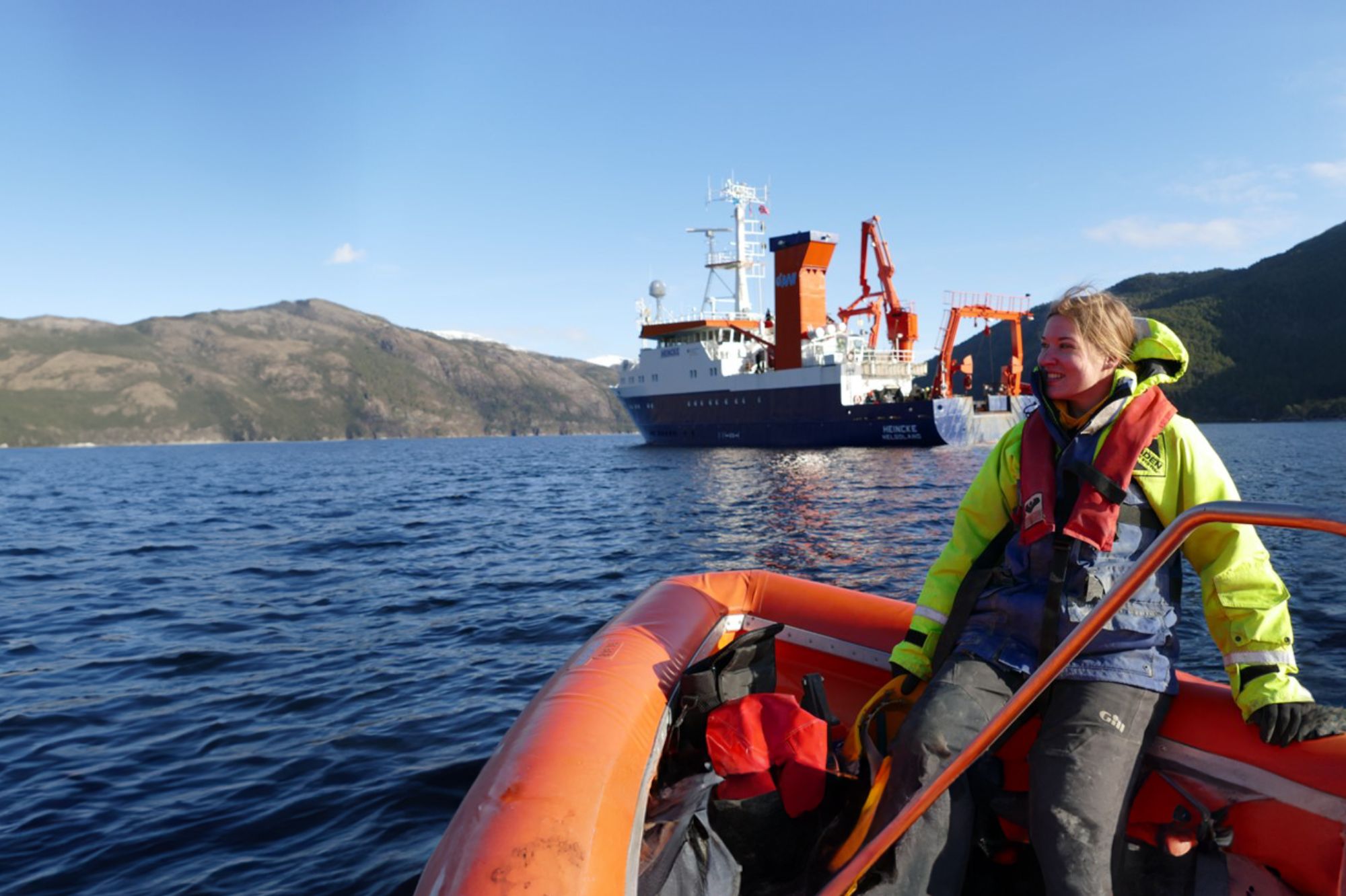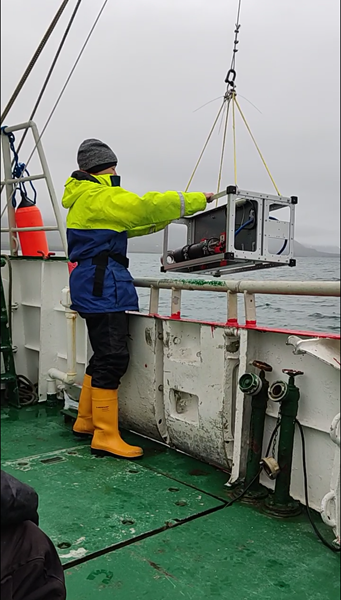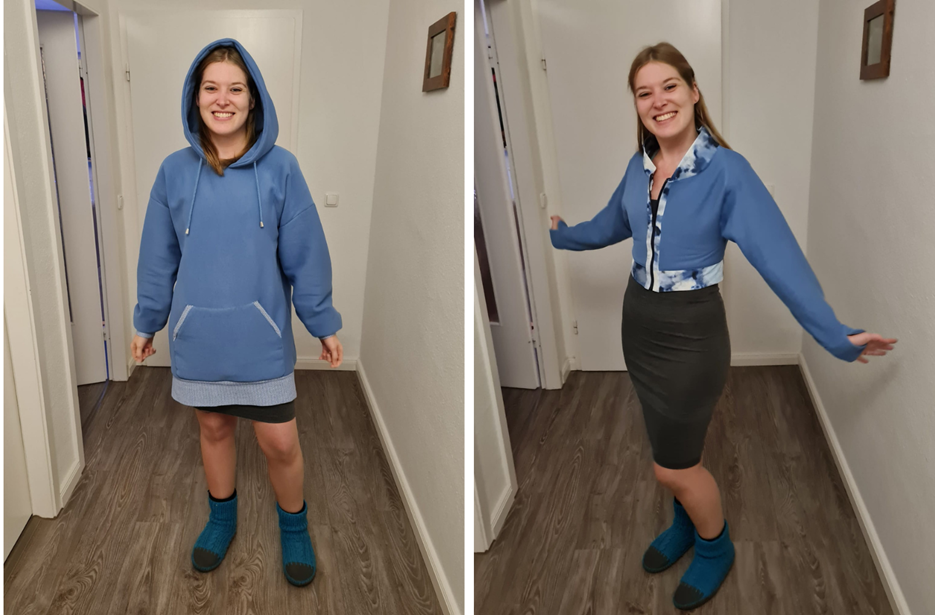Story
Staff spotlight: Dr Saskia Rühl - Digital Marine Biologist
4 September 2023

Above: Saskia during a mooring-retrieval operation, on a sampling campaign on FS Heincke in a Norwegian fjord in 2021
Thank you Saskia for taking some time to talk to us today! And wishing you a warm welcome to Plymouth Marine Laboratory in your new position as Digital Marine Biologist. Although, you’re not 'new’ to PML! Can you tell us about how you first came to work at the laboratory?
“Thank you! My journey at PML actually started in 2013/14, when I was enrolled in the MRes Marine Biology programme at Plymouth University. A large part of that course is an independent research project supervised by a scientist either at PML, the Marine Biological Association, or Plymouth University, and mine was a fun little study concerning the effects of climate change on juvenile dogwhelks with Professor Ana Queirós from PML.”
“Ana and I stayed in touch, and when I was looking for work in 2015 - after having done some other things in the meantime - she gave me the opportunity to be involved in some of her on-going studies as a self-employed laboratory technician. I was very happy to be able to stay involved in science and was hoping to find a funded PhD project to move on to. “
“As my experiences at PML so far had been positive, I was glad when some interesting doctoral projects were advertised just in time! I applied to others as well of course - because there’s a lot of competition out there and not all projects that are advertised end up getting funded - but luckily for me it worked out, and I was able to return to PML as a PhD student in the autumn of 2016.”
“The title of my PhD thesis was a real mouthful: ‘Temporal variability in benthic-pelagic exchanges: Seasonal cycles, inter- and multiannual variability, and long-term climate-change driven trends’. It’s basically all about the fluctuation of particles and dissolved materials between the seafloor and the water column, on various time scales.”
“To complete the PhD, I was enrolled in Southampton University’s SPITFIRE doctoral training partnership, but throughout the near four years duration, I spent barely any time in Southampton. Two out of my three supervisors were from PML (Professor Steve Widdicombe and Professor Ana Queirós, alongside Dr Charlie Thompson from the University of Southampton), so I was based here for the duration of my studies.”
It’s fantastic to hear how Saskia’s time at PML has evolved over the years. Our next question was to ask what she did following the completion of her PhD.
“The end of my PhD was overshadowed by the COVID 19 pandemic, so the last few months of write-up and viva prep were spent in isolation at home. I was incredibly nervous that I would be unable to find a postdoctoral position and may have to take a non-science-related job somewhere or burn through my savings. As a consequence, I started applying for postdoc positions about eight months before my scheduled hand-in date and spent a lot of time worrying about the future. When I was offered a job, I immediately agreed, and did not negotiate the start date other than ensuring that it was after the thesis defence... The viva was on Friday the 31st of July 2020, and I started my new position on Monday the 3rd of August, at the Helmholtz-Zentrum Hereon in Germany.”
“In hindsight I wish I had taken some time off at that point and worried less. My advice to doctoral researchers would definitely be not to make the same mistake, and to allow themselves some downtime after their viva!”
“Other than that though, I have no regrets about taking on the postdoc at Hereon. I learned a lot of new methods in the lab and field, and on the computer, and worked with a great team on some very interesting projects in German, Norwegian and Greenlandic waters! My focus was shifted from the near-seafloor environment to higher up in the water column, and I got involved in working with plankton and particle imaging techniques. Ultimately, I picked up a lot of skills and was able to network thoroughly in the global plankton imaging community.”

Above: Saskia deploying a sampling frame containing pelagic imaging instrumentation and a CTD in Greenland, aboard the Porsild in 2022
“On a personal level I also enjoyed living in Germany a lot. I am German and it was great to live in closer proximity to my family and be immersed in my own culture and language for a change (not to mention to eat all the food I had been missing!). My husband’s German language skills improved a lot, and we now both feel at home in both countries.”
We next asked Saskia how she came to return to PML as a Digital Marine Biologist.
“Although it was not planned that way, my work at Hereon ended up setting me up well for my current position at PML. The Digital Scientist recruitment round targeted people who use different kinds of methods relevant to meeting the goals set in PML’s Digital Science Plan. In my case, my experience working with imaging technology and machine-learning based approaches to classifying imaging data meant that I fit into that mould.”
“One of the bigger things I am involved in now is the APICS project, through which continuous plankton monitoring will be integrated into the on-going L4 time series data collection (as part of the Western Channel Observatory) using two different imagers. I am also a part of an international working group aiming to establish general best practices for plankton imaging, and have been invited to join the executive board of the National Centre for Coastal Autonomy (NCCA).”
“On a day-to-day basis I currently spend most of my time in front of the computer, writing, coding and corresponding with others. However, I am hopeful that in time, some more field work can come into the mix again too, as I enjoy the practical work a lot.”
This led us nicely to our next question, to ask whether Saskia was working on any exciting projects or publications that she could tell us about.
“There is one publication I’m currently working on that is particularly exciting to me: We’re using a mathematical method to deduce organic carbon concentrations in the water based on particle imaging data. It sounds a bit dry but the possibilities opened up by using this method are vast, considering how much underutilised imaging data is out there! It could really help with the determination of the global carbon budget if this method was applied more widely.”
“The work on the current publication is in collaboration with ex-colleagues from Hereon and based on data we collected while I was there. However, I’m hoping to build on it at PML by utilising the instrumentation deployed through APICS to collect and describe the first fully ground-truthed long-term imaging-derived particulate organic carbon time series.”
For our next couple of questions, we wanted to find out a little more about Saskia, the person behind the science! We first asked her what she enjoys about living and working in Plymouth.
“I love being back by the seaside, something that I sorely missed during my time in Germany. Plymouth is, in my opinion, a great base of operations in the Southwest: The city itself may not be the prettiest one out there, but it is surrounded by some amazing nature with all the coast walks, beaches, moors, etc.”
“It’s also noticeable that the city has been much improved over time and the on-going work throughout the city centre and seafront are bound to add to that. As to working in Plymouth, the local marine science community is a strong one, which I am proud to be a part of.”
And, to finish, we asked Saskia what she gets up to in her spare time, or to unwind after a busy day in the office.
“What I do in my time off is quite weather-dependent: I strive to be outdoors as much as possible when the weather is good so on a nice summer day, I love spending the late afternoons and evenings in nature, on a beach or even in the sea swimming and snorkelling.”
“On grey and colder days, I love to sew (mostly clothes) and craft things or read a good book. When work (or life) is stressful, I find that being active is the most effective way to get back to a mindful place, so going to the gym and the climbing hangar helps me to keep a good work-life balance.”
 Above: Saskia with some of her incredible sewing creations! An oversized hoodie and a bolero jacket.
Above: Saskia with some of her incredible sewing creations! An oversized hoodie and a bolero jacket.
Thank you Dr Saskia Rühl for taking the time to chat to us and tell us more about your career and your work.